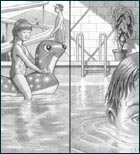
Water from the nearby Owl Creek Mountains filters through porous rock until it hits an area of geothermal activity, which heats the water. Now containing a rich mixture of minerals and chemicals, the water is forced back up to the surface.
Those desiring a refreshing soak in the Thermopolis waters have three choices: the State Bath House and two privately operated facilities, the Star Plunge and the TePee Spa.
The State Bath House is an impressive stone building, featuring indoor and outdoor pools, changing rooms, and private bathtubs for soaking. It is less impressive up close-the outdoor pool’s paint was peeling and the men’s locker room was long overdue for a paint job. There is no charge for admission, but visitors are allowed to remain in the water for only twenty minutes at a time and must then leave the facility for two hours before returning.
The attendant explained that this is to ensure that everyone has access to the facility and because the state health department has determined that twenty minutes in the 104-degree water is the safe amount for “most” people. Dishtowel size towels are provided on request. The attendant told me that during the tourist season 150-200 people use the Bath House a day. No lifeguard is on duty, but since the pools are only three and a half feet deep and large signs warn against “swimming,” there is little need. Switching pools is forbidden.
No additional services or products are sold or rented. The Bath House is open from 8 AM to 5:30 PM Monday to Saturday and noon to 5:30 PM on Sunday.
The Star Plunge and TePee Spa offer quite different experiences from the State Bath House. Both feature large pools, water slides, “vapor caves,” multiple pools at different temperatures, sunbathing and picnic areas, and food and gift shops. Their exteriors are more carnival-like than the State Bath House, but attractively maintained. Both charge admission ($8 for the entire day from 9 AM to 9 PM) but neither puts any limit on how long one can swim.
The admissions clerk at the Star Plunge was surprised when I asked her about a time limit, telling me, “We figure people can tell when they get hot and they will get out themselves.” Water toys were in abundant use, and the laughter and shouts from both private spas were a sharp contrast to the hushed voices my fellow patrons and I fell into at the State Bath House.
There are (at least) five economics lessons here. First, the state facility is a classic example of a state enterprise: overinvestment in capital (that impressive stone building) and underinvestment in maintenance. Building structures wins points for politicians; painting them does not. The private facilities, forced to compete with each other as well as their state competitor, which charges no fees, invested in features that attract customers.
Second, because the State Bath House does not charge for admission, it must have an alternative scheme to ration use-in this case the arbitrary limit of 20 minutes together with the two-hour exile between soaks. No such limits are needed by the private facilities. This also means that the Bath House does not have to serve the customer in order to obtain its funds.
Third, the State Bath House follows a typical regulatory “one-size-fits-all” approach. Because bureaucrats determined that “most” people should not stay in the hot water for more than twenty minutes, no one can stay longer than twenty minutes. The private facilities, on the other hand, rely on individuals’ concern for their own comfort to regulate time in the water and provide pools with different temperature levels to enhance that comfort.
Fourth, the State Bath House has a fixed purpose -soaking in the mineral waters for “health” benefits. (The medical virtues of hot springs were touted in the late 1800s when the hot springs first began to be exploited, but any private business that made health claims for them today would quickly run into trouble with federal regulators.) As early as 1900, the private facilities were installing slides and evolving into more diversified experiences.
Finally, the State Bath House’s hours suit its employees, but, as can be seen from the extended hours offered by the private competitors, they are obviously inadequate to meet the public demand.
By itself, the Thermopolis State Bath House probably does little harm to the economy or our freedom. Yet it is a striking reminder of how deeply socialist institutions are embedded into our economy.
State enterprises are shockingly widespread in America, from public schools to airports. Each suffers from the same problems as the State Bath House. The crumbling infrastructure of urban public schools, the arbitrary rationing that slows down air travel, the poor service at universities’ monopoly textbook stores, the one-size-fits-all approach of virtually every state and federal regulator-all testify to government ownership or control.
I look forward to returning to Thermopolis someday for a truly “free” soak-a swim in a free enterprise system that will have become so pervasive that it has crowded out the regimented State Bath House.
Andrew Morriss spends as much time as he can in the West. He is a Senior Associate of PERC and Associate Dean for Academic Affairs and Galen J. Roush Professor of Business Law and Regulation at Case Western Reserve University School of Law.



